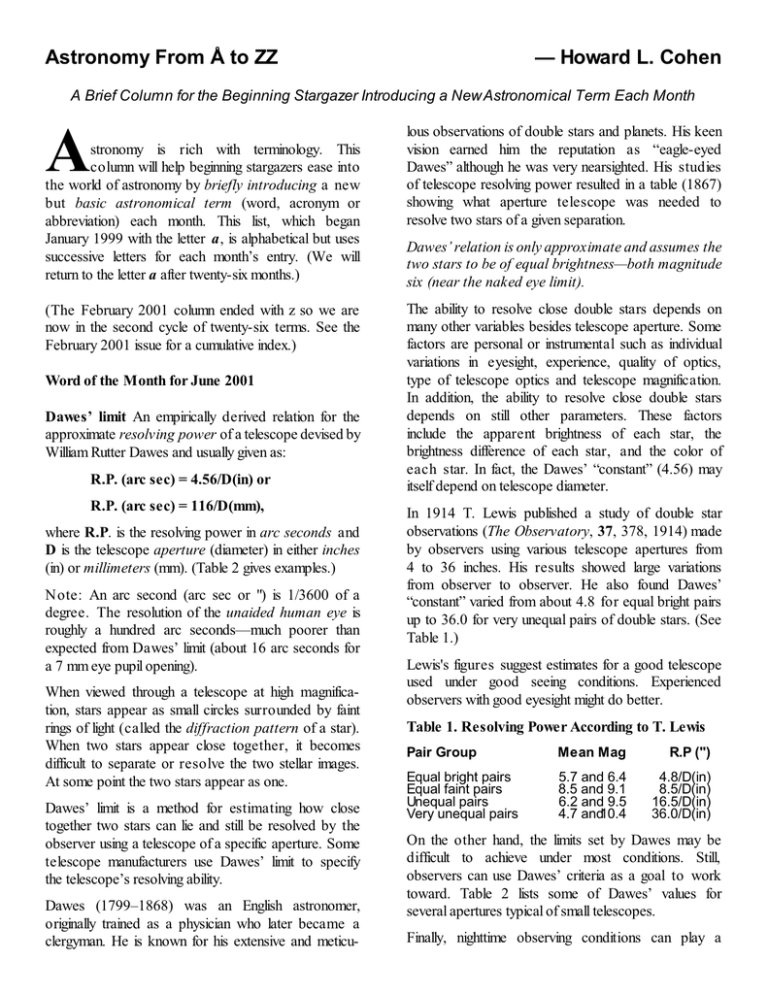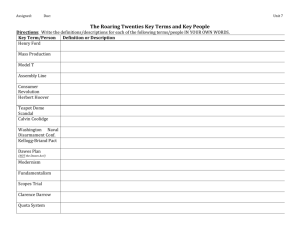Dawes` limit - Astroadventures.net
advertisement

Astronomy From Å to ZZ — Howard L. Cohen A Brief Column for the Beginning Stargazer Introducing a New Astronomical Term Each Month A stronomy is rich with terminology. This column will help beginning stargazers ease into the world of astronomy by briefly introducing a new but basic astronomical term (word, acronym or abbreviation) each month. This list, which began January 1999 with the letter a, is alphabetical but uses successive letters for each month’s entry. (We will return to the letter a after twenty-six months.) (The February 2001 column ended with z so we are now in the second cycle of twenty-six terms. See the February 2001 issue for a cumulative index.) Word of the Month for June 2001 Dawes’ limit An empirically derived relation for the approximate resolving power of a telescope devised by William Rutter Dawes and usually given as: R.P. (arc sec) = 4.56/D(in) or R.P. (arc sec) = 116/D(mm), where R.P. is the resolving power in arc seconds and D is the telescope aperture (diameter) in either inches (in) or millimeters (mm). (Table 2 gives examples.) Note: An arc second (arc sec or ") is 1/3600 of a degree. The resolution of the unaided human eye is roughly a hundred arc seconds—much poorer than expected from Dawes’ limit (about 16 arc seconds for a 7 mm eye pupil opening). When viewed through a telescope at high magnification, stars appear as small circles surrounded by faint rings of light (called the diffraction pattern of a star). When two stars appear close together, it becomes difficult to separate or resolve the two stellar images. At some point the two stars appear as one. Dawes’ limit is a method for estimating how close together two stars can lie and still be resolved by the observer using a telescope of a specific aperture. Some telescope manufacturers use Dawes’ limit to specify the telescope’s resolving ability. Dawes (1799–1868) was an English astronomer, originally trained as a physician who later became a clergyman. He is known for his extensive and meticu- lous observations of double stars and planets. His keen vision earned him the reputation as “eagle-eyed Dawes” although he was very nearsighted. His studies of telescope resolving power resulted in a table (1867) showing what aperture telescope was needed to resolve two stars of a given separation. Dawes’ relation is only approximate and assumes the two stars to be of equal brightness—both magnitude six (near the naked eye limit). The ability to resolve close double stars depends on many other variables besides telescope aperture. Some factors are personal or instrumental such as individual variations in eyesight, experience, quality of optics, type of telescope optics and telescope magnification. In addition, the ability to resolve close double stars depends on still other parameters. These factors include the apparent brightness of each star, the brightness difference of each star, and the color of each star. In fact, the Dawes’ “constant” (4.56) may itself depend on telescope diameter. In 1914 T. Lewis published a study of double star observations (The Observatory, 37, 378, 1914) made by observers using various telescope apertures from 4 to 36 inches. His results showed large variations from observer to observer. He also found Dawes’ “constant” varied from about 4.8 for equal bright pairs up to 36.0 for very unequal pairs of double stars. (See Table 1.) Lewis's figures suggest estimates for a good telescope used under good seeing conditions. Experienced observers with good eyesight might do better. Table 1. Resolving Power According to T. Lewis Pair Group Mean Mag R.P (") Equal bright pairs Equal faint pairs Unequal pairs Very unequal pairs 5.7 and 6.4 8.5 and 9.1 6.2 and 9.5 4.7 and10.4 4.8/D(in) 8.5/D(in) 16.5/D(in) 36.0/D(in) On the other hand, the limits set by Dawes may be difficult to achieve under most conditions. Still, observers can use Dawes’ criteria as a goal to work toward. Table 2 lists some of Dawes’ values for several apertures typical of small telescopes. Finally, nighttime observing conditions can play a major role, especially under poor “seeing” conditions —turbulent air that distorts the quality of the image. In fact, poor seeing typically limits the resolving power of most large, ground-based telescopes so resolving double stars closer than 0.5 to one arc second is usually difficult or impossible. (New interferometer techniques including the Fine Guidance Sensors on the Hubble Space Telescope can now do better.) Since Dawes’ limit for a ten-inch aperture telescope is about 0.5 arc seconds, a ten-inch telescope can typically resolve a close double star as well as most larger aperture telescopes. Thus, amateurs who use telescopes with diameters larger than about ten inches (250 mm) will not resolve detail better than smaller aperture telescopes. ' References. J. Mitton 1991, Concise Dictionary of Astronomy (Oxford Univ. Press); I. Ridpath 1997, A Dictionary of Astronomy (Oxford Univ. Press); R.G. Aitken, The Binary Stars, 1964 (Dover). Table 2. Dawes’ Limit (for two 6th mag. stars) Aperture Limit Aperture Limit 50 mm (2.0 in.) 2.3" 150 mm (6 in) 0.8" 60 mm (2.4 in.) 1.9" 180 mm (7 in.) 0.6" 80 mm (3.1 IN.) 1.4" 200 mm (8 Iin.) 0.6" 90 mm (3.5 in.) 1.3" 250 mm (10 in.) 0.5" 100 mm (4 in.) 1.2" 280 mm (11 in.) 0.4" 125 mm (5 in.) 0.9 300 mm (12 in.) 0.4" Table Notes: 1. Apertures (D) given in millimeters (mm) with approximate equivalent values in inches given in parentheses. Dawes’ limits (rounded to one decimal place) are in arc seconds ("). 2. Atmospheric turbulence limits the resolution of telescopes larger than about 250 mm (10 in.) to about 0.5 arc seconds.



